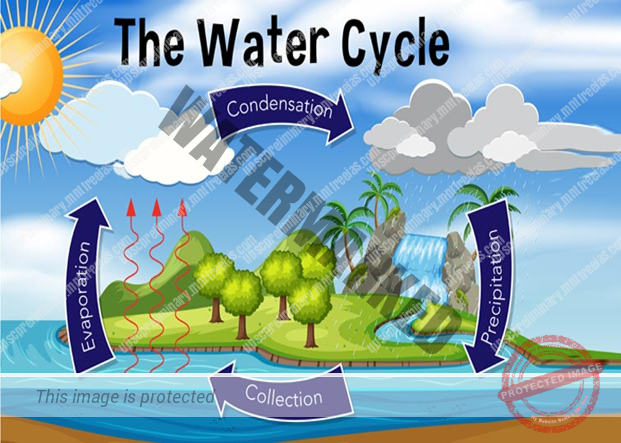- HYDEROLOGICAL CYCLE (WATER CYCLE)
UNIT 2 – BIOGEOCHEMICAL CYCLE – PART 3
The Water Cycle:
The Hydrological Cycle
70% of the earth’s surface is covered with water but still, the world is facing an acute water crisis. This is because, out of total water available on earth, 97.5% is saltwater. Of the remaining water, 99% is locked in glaciers and underground sources. So, technically, less than 1% of fresh water is available for human use in the form of rivers, lakes, streams, etc. please note that this less than 1% water availability is sufficient to fulfil the needs of even the last man on this planet.
But owing to human encroachments at all levels, the existence of mankind will be at risk in the near future if proper precautionary measures for optimum use of water resources are not put in place. For instance, 12% of the Indian population is already at the brunt of the “day zero” scenario.
To tackle this global problem of the water crisis, let us understand the genesis of the water cycle through this article.
Hydrological cycle (Water cycle)
The water cycle is defined as continuous circulation of water from the earth to atmosphere and vice versa which is powered by the energy of the sun. It shows storage and movement of water between biosphere, lithosphere, and hydrosphere.
Major Water Sinks
Water can be stored in any of the reservoirs like atmosphere, oceans, lakes, rivers, soils, glaciers, snowfields and groundwater.
Processes involved
- The processes involved in the movement of water from one reservoir to another are-
- Evaporation, condensation, precipitation, deposition, runoff, infiltration, sublimation, transpiration, melting and groundwater flow.
- The driving source of energy for the water cycle is solar radiation or solar energy.
- Evaporation and precipitation are the main processes involved in the water cycle.
- Some of the processes are discussed below:
- Evaporation– Water from ocean, lakes, ponds, rivers and streams evaporates by sun’s heat and energy. Water remains in vapour state in air and forms cloud.
- Transpiration– Evaporation through the plant surface due to solar energy is known as transpiration. Plants also transfer a huge amount of water in the atmosphere through transpiration.
- Precipitation– Cloud meets with the cold air in the mountains and above forest regions and condenses to form rain precipitates.
- Condensation– It is the process by which water vapours in the atmosphere gets converted into liquid droplets.
- Runoff: Water discharged from the surface is known as runoff. If it is discharged through rivers, it is known as river runoff.
The ocean supplies most of the evaporated water. On average 84% of water loss from the oceans through evaporations while 77% gained by precipitation. Water from runoff, streams and river covers the 7% to balance evaporation deficit of oceans. On land, evaporation is 16% and precipitation is 23%.

உயிர் வேதியியல் சுழற்சிகள் -02
நீர்நிலை சுழற்சி அல்லது நீர் சுழற்சி:
பூமியின் மேற்பரப்பில் 70% நீரால் மூடப்பட்டிருக்கிறது, ஆனால் இன்றளவும், உலகம் கடுமையான நீர் நெருக்கடியை எதிர்கொள்கிறது. ஏனென்றால், பூமியில் கிடைக்கும் மொத்த நீரில், 97.5% உப்புநீராகும். மீதமுள்ள நீரில், 99% பனிப்பாறைகள் மற்றும் நிலத்தடி மூலங்களில் பூட்டப்பட்டுள்ளது. எனவே, தொழில்நுட்ப ரீதியாக, ஆறுகள், ஏரிகள், நீரோடைகள் போன்ற வடிவங்களில் மனித பயன்பாட்டிற்கு 1% க்கும் குறைவான புதிய நீர் கிடைக்கிறது. இது 1% க்கும் குறைவான நீர் ஆதாரம் இந்த கிரகத்தில் இருக்கும் கடைசி மனிதன் வரை இந்த 1 சதவிகித குறைவானநீர் இருப்பு போதுமானதாக அமையும் என்றே கருதலாம்.
ஆனால் அனைத்து மட்டங்களிலும் மனிதர்கள் அத்துமீறல் காரணமாக, நீர் வளங்களை உகந்த முறையில் பயன்படுத்துவதற்கான சரியான முன்னெச்சரிக்கை நடவடிக்கைகள் மேற்கொள்ளப்படாவிட்டால், எதிர்காலத்தில் மனிதகுலத்தின் இருப்பு ஆபத்தில் இருக்கும். உதாரணமாக, இந்திய மக்கள்தொகையில் 12% பேர் ஏற்கனவே நீர் நெருக்கடியின் பூஜிய சதவீத சூழ்நிலையை எதிர்கொண்டு வருகின்றனர் .
நீர் நெருக்கடியின் இந்த உலகளாவிய சிக்கலைச் சமாளிக்க, இந்த கட்டுரையின் மூலம் நீர் சுழற்சியின் தோற்றத்தை புரிந்து கொள்வோம்
நீர்நிலை சுழற்சி (நீர் சுழற்சி)
நீர் சுழற்சி என்பது பூமியிலிருந்து வளிமண்டலத்திற்கு தொடர்ச்சியாக நீர் சுழற்சி மற்றும் நேர்மாறாக சூரியனின் ஆற்றலால் இயக்கப்படுகிறது. இது உயிர்க்கோளம், நிலக்கோளம் மற்றும் நீர்க்கோளம் இடையே நீரின் சேமிப்பு மற்றும் இயக்கத்தைக் காட்டுகிறது.
முக்கிய நீர் தேக்கிகள் வளிமண்டலம், பெருங்கடல்கள், ஏரிகள், ஆறுகள், மண், பனிப்பாறைகள், பனிப்பொழிவு மற்றும் நிலத்தடி நீர் போன்ற எந்த நீர்த்தேக்கங்களிலும் தண்ணீரை சேமிக்க முடியும்.
நீர்நிலை சுழற்சி சம்பந்தப்பட்ட செயல்முறைகள்
ஒரு நீர்த்தேக்கத்திலிருந்து இன்னொரு இடத்திற்கு நீரை நகர்த்துவதில் ஈடுபடும் செயல்முறைகள்-
ஆவியாதல், ஒடுக்கம், மழைப்பொழிவு, படிதல், ஓட்டம், ஊடுருவல், பதங்கமாதல், டிரான்ஸ்பிரேஷன்(ஆவியுயிர்ப்பு) , உருகுதல் மற்றும் நிலத்தடி நீர் ஓட்டம்.
நீர் சுழற்சிக்கான ஆற்றலின் உந்துதல் ஆதாரம் சூரிய கதிர்வீச்சு அல்லது சூரிய சக்தி.
ஆவியாதல் மற்றும் மழைப்பொழிவு ஆகியவை நீர் சுழற்சியில் ஈடுபடும் முக்கிய செயல்முறைகள்.
சில செயல்முறைகள் கீழே விவாதிக்கப்பட்டுள்ளன:
ஆவியாதல்- கடல், ஏரிகள், குளங்கள், ஆறுகள் மற்றும் நீரோடைகளில் இருந்து வரும் நீர் சூரியனின் வெப்பம் மற்றும் ஆற்றலால் ஆவியாகிறது. நீர் காற்றில் நீராவி நிலையில் உள்ளது மற்றும் மேகத்தை உருவாக்குகிறது.
டிரான்ஸ்பிரேஷன் (ஆவியுயிர்ப்பு ) – சூரிய ஆற்றல் காரணமாக தாவர மேற்பரப்பு வழியாக ஆவியாதல் டிரான்ஸ்பிரேஷன் (ஆவியுயிர்ப்பு ) என்று அழைக்கப்படுகிறது. தாவரங்கள் வளிமண்டலத்தில் ஒரு பெரிய அளவிலான தண்ணீரை டிரான்ஸ்பிரேஷன் மூலம் மாற்றுகின்றன.
மழைப்பொழிவு- மலைகள் மற்றும் வனப்பகுதிகளுக்கு மேலே உள்ள குளிர்ந்த காற்றை மேகங்கள் ஈர்த்து மழையை பொழிவிக்கிறது .
ஒடுக்கம்- இது வளிமண்டலத்தில் உள்ள நீராவிகள் திரவத் துளிகளாக மாற்றப்படும் செயல்முறையாகும்.
நீர் ஓட்டம்: மேற்பரப்பில் இருந்து வெளியேற்றப்படும் நீர் ஓட்டம் என அழைக்கப்படுகிறது. இது ஆறுகள் வழியாக வெளியேற்றப்பட்டால், அது நதி ஓட்டம் என்று அழைக்கப்படுகிறது.
ஆவியாக்கப்பட்ட நீரின் பெரும்பகுதியை கடல் வழங்குகிறது. கடல்களில் இருந்து ஆவியாதல் மூலம் சராசரியாக 84% நீர் இழப்பு, 77% மழைப்பொழிவு மூலம் பெறப்பட்டது. கடல்களின் ஆவியாதல் பற்றாக்குறையை சமநிலைப்படுத்த நீர் ஓட்டம், நீரோடைகள் மற்றும் நதியிலிருந்து வரும் நீர் 7% ஐ உள்ளடக்கியது. நிலத்தில், ஆவியாதல் 16% மற்றும் மழைப்பொழிவு 23% ஆகும்.
